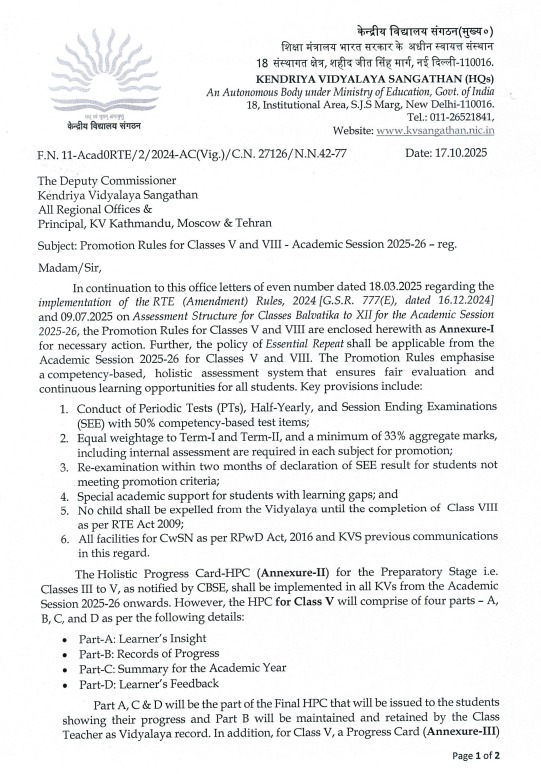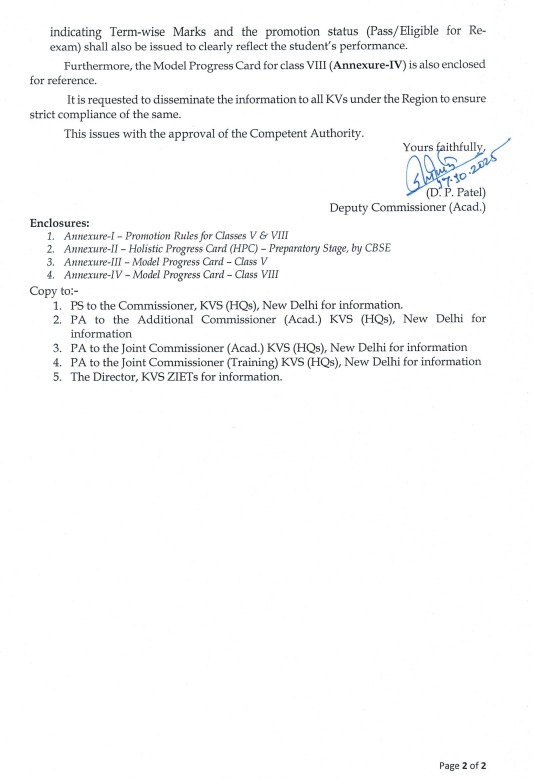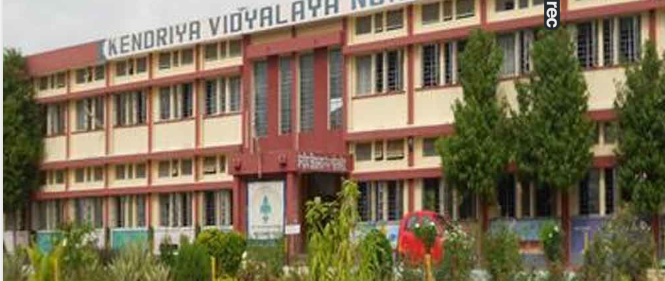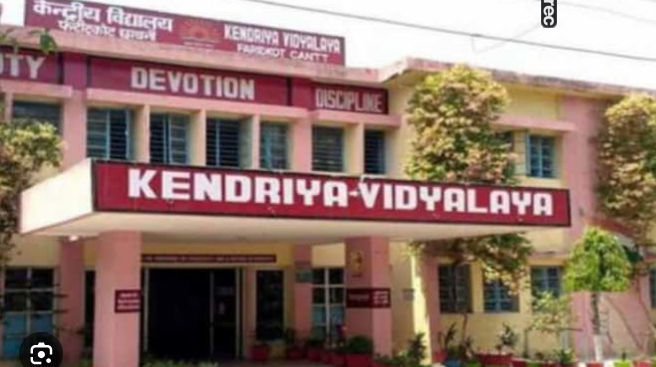
Table of Contents
KVS Promotion Rules for Classes V and VIII – Academic Session 2025–26
On 17 October 2025, Kendriya Vidyalaya Sangathan (KVS) released a notification reaffirming and detailing the Promotion Rules for Classes V and VIII for the the Academic Session 2025–26. This circular builds upon earlier communications — notably the letters of 18 March 2025 regarding the implementation of the RTE (Amendment) Rules, 2024 [G.S.R. 777(E), dated 16 December 2024], and the document of 9 July 2025 about the assessment structure for Classes Balvatika through XII.
The notification also states that these Promotion Rules, attached as Annexure-I, should be put into effect immediately in all Kendriya Vidyalayas (KVs). Moreover, a policy of Essential Repeat is introduced for Classes V and VIII from 2025–26 onward.
This report provides a detailed breakdown of the rules, highlights key features, discusses potential implications and challenges, and offers recommendations for implementation.
1. Objective of the New Promotion Rules
The revised promotion framework aims to:
Establish a competency-based assessment structure that measures real learning outcomes rather than rote memorization.
Promote continuous and fair evaluation for all learners.
Offer supportive interventions for students with learning difficulties.
Ensure compliance with the RTE Act, 2009, guaranteeing no child is expelled until completion of Class VIII.
2. Key Provisions of the Promotion Rules
The circular outlines several important features of the new promotion framework. Below is a synthesized summary:
2.1 Competency-Based Assessment (50%)
Every Periodic Test (PT), Half-Yearly examination, and Session Ending Examination (SEE) must include at least 50% competency-based items.
Such items are designed to test higher-order thinking rather than purely factual recall.
2.2 Term Weightage & Minimum Marks
Term I and Term II shall carry equal weightage in the final assessment.
For a student to be promoted, they must secure a minimum of 33% aggregate marks in each subject, inclusive of internal assessments.
2.3 Re-examination Provision
If a student fails to meet the promotion criteria (i.e., less than 33% in a subject), a re-exam shall be conducted within two months of the SEE result declaration.
This ensures a second chance for students to reach the required benchmark.
2.4 Essential Repeat Policy
From the 2025–26 session, the Essential Repeat policy will apply: students still not meeting criteria after re-exam may be required to repeat the class.
This underscores the commitment that learning outcomes must be met before progression.
2.5 Support for Students with Learning Gaps
The rules mandate special academic support mechanisms to assist students who lag behind.
This includes remedial classes, targeted interventions, and teacher oversight to bridge learning deficits before re-examinations.
2.6 Non-expulsion up to Class VIII
In accordance with RTE Act, 2009, no child shall be expelled up to the end of Class VIII.
This reaffirms the protective clause for children vulnerable to failure and exclusion.
2.7 Inclusion and Accommodations for CwSN
All facilities and accommodations for Children with Special Needs (CwSN) must be provided, per the RPwD Act, 2016, and prior KVS guidelines.
This assures that the assessment framework is inclusive and equitable.
3. Holistic Progress Card (HPC) & Progress Cards
A major shift accompanies the promotion rules: the adoption of a Holistic Progress Card (HPC) format as mandated by CBSE for the Preparatory Stage (Classes III to V), with specific configuration for Class V.
3.1 Structure of the Holistic Progress Card for Class V
The HPC for Class V will have four parts:
Part A: Learner’s Insight — capturing attitudes, interests, values, and dispositions
Part B: Records of Progress — detailed academic & co-scholastic records, retained by the class teacher
Part C: Summary for the Academic Year — synthesizing key achievements
Part D: Learner’s Feedback — self-reflection by the student
Parts A, C, and D will form the final HPC issued to the learner, while Part B is an internal record held at the Vidyalaya.
Click here to download the full notification in PDF


3.2 Term-wise Progress Card for Class V
In addition to the HPC, a separate Progress Card (Annexure-III) will be issued for Class V showing:
Term-wise marks for each subject
A promotion status indicator (Pass / Eligible for Re-examination)
This ensures transparency and helps students, parents, and teachers monitor performance.
3.3 Model Progress Card for Class VIII
A Model Progress Card (Annexure-IV) is provided for Class VIII. It will capture:
Term-wise and subject-wise marks
Details of internal assessments
Indicators of competency-based evaluation
Final promotion status
This aligns the reporting format of Class VIII with the new competency-based philosophy.
4. Implications of the New Rules
These revised promotion norms carry several implications — pedagogical, administrative, and student-centric.
4.1 Emphasis on Continuous Learning
By distributing weight equally across terms and including internal assessment, KVS encourages ongoing learning efforts rather than a last-minute push. This reduces exam-centric pressure.
4.2 Pressure to Ensure Mastery
The Essential Repeat clause signals a stricter stance: progression is contingent upon mastering required competencies. This could increase accountability but also stress for students and teachers.
4.3 Increased Workload for Teachers
Teachers will have greater responsibility in designing competency-based items, maintaining detailed records (especially Part B of HPC), and providing remedial support.
Training, capacity-building, and resource allocation become critical factors.
4.4 Inclusion Imperative
Adhering to RPwD and RTE mandates, KVs must integrate accommodations for diverse learners. Schools must ensure resource teachers, assistive tools, and differentiated evaluation to uphold fairness.
4.5 Clarity and Communication
With multiple new formats and rules (HPC, Progress Cards, reexams, essential repeat), clear communication with students, parents, and staff is essential to avoid confusion or anxiety.
5. Challenges and Risk Factors
While well-intentioned, implementation may face hurdles:
Teacher preparedness: Designing valid competency-based items is not trivial; many teachers may need training.
Resource constraints: Some Vidyalayas, especially in remote areas, may lack support staff, remedial facilities, or infrastructure for CwSN.
Parental pushback: The stricter policy of repeat may concern parents. Transparent orientation is necessary.
Time constraints: Conducting re-exams and remedial support within a two-month window may be logistically tight.
Consistency across KVs: Uniform application across all Kendriya Vidyalayas in diverse contexts may pose standardization challenges.
6. Recommendations for Effective Implementation
To ensure the success of the policy, several strategic measures should be adopted:
Professional Development & Training – Organize workshops for teachers on designing competency-based assessments, inclusive pedagogy, and use of the HPC format.
Orientation for Stakeholders – Conduct meetings with parents, students, and teachers to explain the new rules, benefits, and expectations.
Remedial Support Framework – Establish regular remedial classes, peer tutoring, and summer bridging programs to help students with learning gaps.
Resource Allocation – Equip Vidyalayas with additional resource teachers, assistive technology, and learning materials, especially for CwSN support.
Monitoring & Feedback Mechanism – Create oversight teams at regional and national levels to monitor compliance, identify bottlenecks, and gather feedback.
Time Management Planning – Prepare detailed schedules so that re-examinations, remediation, and reporting occur smoothly within the stipulated time.
Template Standardization – Ensure all Vidyalayas receive standard templates (Annexures I–IV) and guidelines to reduce variation.
Data-Driven Review – After the first year, analyze pass rates, repeat cases, and feedback to iterate and improve the policy.
7. Conclusion
The KVS Promotion Rules for Classes V and VIII (Academic Session 2025–26) mark a transformative shift in evaluation philosophy. Anchoring emphasis on competency, fairness, inclusivity, and holistic development, the new guidelines aim to move away from mere memorization toward meaningful learning. The introduction of Essential Repeat, re-examination, and Holistic Progress Cards underscores the commitment to ensure that no student advances without foundational understanding.
Successful execution will require strong leadership, adequate resources, and sustained capacity building. If implemented effectively, these rules can reshape the learning environment of Kendriya Vidyalayas — making assessments more just, transparent, and growth-oriented.
Click here to download the full notification in PDF

Disclaimer:
This report on KVS Promotion Rules for Classes V and VIII – Academic Session 2025–26 is based on the official notification issued by Kendriya Vidyalaya Sangathan (KVS) on 17 October 2025. The content presented here is for informational and educational purposes only. Readers are advised to refer to the official KVS circulars and annexures available on the KVS website (www.kvsangathan.nic.in) for detailed and authentic information. The publisher of this article is not responsible for any discrepancies, updates, or policy changes made by KVS or the Ministry of Education after the publication of this report.

For more information and updates please follow the page and don’t forget to leave your comment.
